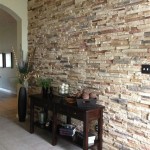How To Clean Interior Cinder Block Walls
Cinder block walls, also known as concrete block walls, are a common feature in many commercial and residential structures, particularly in basements, garages, and industrial spaces. Their durability and affordability make them a popular choice, but their porous nature can also make them susceptible to accumulating dirt, dust, mildew, and efflorescence over time. Proper cleaning is essential not only for aesthetic purposes but also to maintain the structural integrity of the walls and prevent the growth of harmful organisms. This article provides a comprehensive guide on how to effectively clean interior cinder block walls, ensuring a clean and healthy environment.
Before embarking on the cleaning process, it's crucial to understand the type of soiling present on the wall. Common culprits include dust and dirt, often easily removed with basic cleaning solutions. Mildew, characterized by a musty odor and dark staining, requires more specialized cleaning agents. Efflorescence, a white, powdery deposit resulting from salt deposits leaching from the concrete, necessitates specific treatments to prevent its recurrence. Identifying the type of stain or buildup will directly influence the selection of appropriate cleaning methods and solutions.
Safety is paramount when cleaning any surface, and cinder block walls are no exception. Proper ventilation is crucial, especially when using chemical cleaning agents. Open windows and doors to allow for adequate airflow. Protective gear, including gloves, eye protection (goggles or a face shield), and a dust mask or respirator, should be worn to prevent skin and respiratory irritation from cleaning solutions and dislodged particles. Consider wearing old clothing that can be easily cleaned or discarded after the cleaning process.
Preparation and Assessment
Thorough preparation is key to efficient and effective cleaning. Begin by removing any loose debris from the wall surface. This includes sweeping or vacuuming away dust, dirt, and cobwebs. A stiff-bristled brush can be used to dislodge more stubborn particles. Pay particular attention to corners and crevices where debris tends to accumulate. If the wall is painted, assess the condition of the paint. Loose or peeling paint should be scraped away before cleaning to prevent further damage and ensure that the cleaning solution does not seep underneath the paint layer.
Inspect the wall for any structural damage, such as cracks or crumbling mortar. Address any significant damage before cleaning, as the cleaning process could exacerbate existing problems. Minor cracks can often be patched with a concrete patching compound. More extensive damage may require professional repair.
Once the wall is prepared, test the selected cleaning solution in an inconspicuous area, such as behind furniture or in a corner. This will help determine if the solution discolors or damages the cinder block. Allow the test area to dry completely before proceeding with the overall cleaning process. This step is particularly important when using chemical cleaning agents or when dealing with painted cinder block walls.
Cleaning Methods and Solutions
The appropriate cleaning method depends on the type and severity of the soiling. For light dust and dirt, a simple solution of warm water and mild detergent is often sufficient. A solution of dish soap and water can be effective. For more stubborn stains, a stronger cleaning agent may be necessary. Always start with the mildest solution possible and gradually increase the strength as needed.
Basic Cleaning with Soap and Water: This is the least abrasive and most environmentally friendly method. Mix warm water with a mild detergent, such as dish soap or laundry detergent. Apply the solution to the wall using a sponge, scrub brush, or spray bottle. Scrub the wall thoroughly, paying attention to areas with heavy soiling. Rinse the wall with clean water to remove any soap residue. Use a clean cloth or sponge to dry the wall. This method is effective for removing surface dirt and dust.
Cleaning with Vinegar: Vinegar is a natural disinfectant and cleaner that can be effective for removing mildew and light efflorescence. Mix equal parts white vinegar and water. Apply the solution to the wall using a spray bottle or sponge. Allow the solution to sit for 10-15 minutes to loosen the stains. Scrub the wall with a scrub brush or sponge. Rinse the wall thoroughly with clean water. Vinegar can have a strong odor, so ensure adequate ventilation during and after the cleaning process. This method is suitable for removing mildew stains and light efflorescence.
Cleaning with Bleach: Bleach is a powerful disinfectant that can effectively remove mold and mildew. However, it should be used with caution, as it can damage some surfaces and release harmful fumes. Mix one part bleach with ten parts water. Always add bleach to water, never water to bleach, to prevent dangerous chemical reactions. Apply the solution to the wall using a spray bottle or sponge. Allow the solution to sit for 10-15 minutes. Scrub the wall thoroughly with a scrub brush or sponge. Rinse the wall thoroughly with clean water. Ensure adequate ventilation during and after the cleaning process. Wear appropriate protective gear, including gloves, eye protection, and a respirator. Bleach should not be mixed with other cleaning agents, as this can create toxic fumes. This method is best for removing heavy mold and mildew stains.
Cleaning with Trisodium Phosphate (TSP): TSP is a strong cleaning agent that can remove heavy grease, grime, and efflorescence. However, it is a harsh chemical and should be used with extreme caution. Follow the manufacturer's instructions for dilution and application. Wear appropriate protective gear, including gloves, eye protection, and a respirator. Apply the solution to the wall using a scrub brush or sponge. Scrub the wall thoroughly. Rinse the wall thoroughly with clean water. TSP can damage some surfaces, so test it in an inconspicuous area before applying it to the entire wall. TSP is also an environmental pollutant, so dispose of it properly. This method is suitable for removing heavy grease, grime, and stubborn efflorescence.
Addressing Specific Problems
Specific problems require specialized treatments. Mildew, for example, necessitates a solution with antifungal properties. A bleach solution (as described above) is a common choice, but be sure to wear appropriate safety gear and ensure thorough ventilation. For efflorescence, a muriatic acid solution can be used, but this requires extreme caution due to its corrosive nature. Always follow the manufacturer's instructions and wear appropriate protective gear when using muriatic acid. A wire brush can be used to scrub away the efflorescence before applying the acid solution. After cleaning with muriatic acid, thoroughly rinse the wall with clean water to neutralize any remaining acid residue.
If the cinder block walls are painted, it is important to use cleaning solutions that are safe for painted surfaces. Avoid using abrasive cleaners or harsh chemicals, as these can damage the paint. A mild detergent and water solution is usually sufficient for cleaning painted cinder block walls. If the paint is peeling or flaking, it may need to be repainted after cleaning. Consider using a primer designed for concrete surfaces to ensure proper adhesion of the new paint.
For graffiti removal, specialized graffiti removal products are available. Follow the manufacturer's instructions for application and removal. Test the product in an inconspicuous area before applying it to the entire graffiti-covered area. In some cases, it may be necessary to repaint the wall after removing graffiti.
Application Techniques and Tools
The application technique is as important as the cleaning solution itself. For broad surfaces, a spray bottle or garden sprayer can be used to apply the cleaning solution evenly. A scrub brush with stiff bristles is essential for agitating the solution and dislodging dirt and grime. For corners and crevices, a smaller brush or sponge may be necessary. Use a circular motion when scrubbing to ensure thorough cleaning. Avoid applying excessive pressure, as this could damage the wall surface.
Rinsing is a critical step in the cleaning process. Use a garden hose or a bucket of clean water and a sponge to thoroughly rinse the wall after scrubbing. Ensure that all cleaning solution residue is removed, as this can attract dirt and dust. Pay particular attention to vertical surfaces, as cleaning solution can run down the wall and leave streaks. Use a clean cloth or sponge to wipe away any drips or streaks.
Drying the wall is also important to prevent the growth of mold and mildew. Use a clean cloth or sponge to dry the wall after rinsing. If possible, allow the wall to air dry completely. This may take several hours or even a day, depending on the humidity. Ensure adequate ventilation during the drying process. A dehumidifier can be used to speed up the drying process in humid environments.
Post-Cleaning Maintenance and Prevention
After cleaning the cinder block walls, it is important to implement measures to prevent future soiling. Regular dusting and vacuuming can help prevent the buildup of dust and dirt. Addressing any moisture problems, such as leaks or condensation, can prevent the growth of mold and mildew. Consider applying a sealant to the cinder block walls to prevent water penetration and efflorescence. A masonry sealer can help protect the walls from the elements and make them easier to clean in the future.
Proper ventilation is also crucial for preventing moisture problems. Ensure that the area is well-ventilated by opening windows and doors regularly. A dehumidifier can be used to maintain a low humidity level, especially in basements or other damp areas. Avoid storing items directly against the walls, as this can trap moisture and promote the growth of mold and mildew.
Inspect the cinder block walls regularly for any signs of damage or soiling. Address any problems promptly to prevent them from becoming more severe. Minor cracks or damage can be repaired with a concrete patching compound. Stains or mildew can be cleaned with appropriate cleaning solutions. Regular maintenance will help keep the cinder block walls clean and in good condition for years to come.

How To Clean An Exposed Internal Brick Or Masonry Wall Floorseal

How To Clean Interior Exposed Brick Wall Fast Easy Diy Tutorial

How To Clean An Exposed Internal Brick Or Masonry Wall Floorseal

11 Concrete Block Waterproofing Tips Polyguard

How To Clean Interior Brick Walls The Ultimate Guide 2025

Interior Brick Restoration Cleaning By Hand Part One

How To Safely Clean Brick Interiors Turnbull Masonry

How To Clean Brick Backsplash And Do A Great Job

The Ultimate Guide To Clean Any Interior Or Exterior Wall 2025

Clean And Green Brick Cleaning
Related Posts








